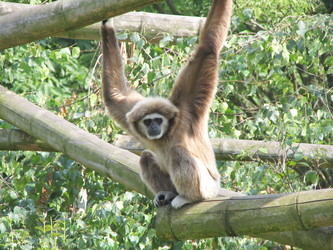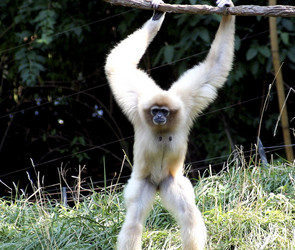The gibbon is a member of the Primates. They are small (24–36 inches tall and 11–18 pounds in weight) arboreal apes which live in the rainforests of Southeast Asia and Indonesia, up to the forest of the highlands of China (Geissmann Gibbon Research Lab: Distribution). They are considered to be endangered, primarily because of human intrusion into their habitat. Gibbons are known for their ability to swing great distances from branch to branch in the forest canopy. This is known as brachiation. They are also known for the monogamous family units in which they live (Geissmann Gibbon Research Lab: Behavioral Ecology).
While not directly in lineage with the humans, gibbons and humans do share a common ancestor. This animal was an anthropoid ape (Freedman 2007). Gibbons closely resemble humans in many features, including having no tail, a semi-erect posture, the shape of their vertebral column, sternum and pelvis, the adaptation of the arm to turn palm-side upwards, similar small intestinal features, and the size of the cerebral hemisphere and number of convolutions. However, compared to other primates, the gibbon’s cognitive ability is low (Freedman 2007).


Lar Gibbon at Tierpark Berlin, August 2004. © Matthias Trautsch
Habitat
The gibbons, whose family name, Hylobatidae, is Greek for “dweller in the trees”, range in habitat from sea level tropical forests to montane forests of 8,000 feet, and from southwest China to northeast India, to southeast Asia, as well as Sumatra, Borneo, and Java (Geissmann Gibbon Research Lab: Distribution). They are rarely on the ground. When gibbons find themselves on the ground, they are always bipedal, walking upright with their arms high in the air for balance. They spend the vast majority of their time in the tree canopy; foraging for fruits and leaves, defending their territory through vocalization from other gibbon groups, and raising their offspring (Geissmann Gibbon Research Lab: Behavioral Ecology). They are the only ape that does not build a nest. Instead, they sleep erect in the tree canopy at night, resting on tree limbs, with their buttock protected by tough horn-like pads (Cawthon Lang 2005).
Social Organization
The usual family group is a bonded male and female, and will also include the offspring of the bonded pair (Sommer and Reichard 2000). It has long been believed that gibbons form life-long monogamous relationships with a mate. More recent studies have found that while gibbons have a paired mating system similar to monogamy, it may involve polyandry, copulation outside the bonded pair, as well as serial monogamy (Sommer and Reichard 2000). Gibbon offspring become physically independent at about 3 years, and physically mature at 6. They leave the family unit at sexually maturity, which occurs at about 8 years old (Sommer and Reichard 2000).


Mother and child White-cheeked gibbon. © 1998-2005 M. A. Clark, WhoZoo
The female is the dominant member of the family, followed by her female offspring, then male offspring, and finally male mate. Within the family group, grooming is an important social activity between adults, adult and young adult offspring, and between adults and infants (Smithsonian National Zoological Park Fact Sheet: Gibbons). When infants are present in the family, there will be play activity centered around them (Brockelman et al. 1998).
Reproduction and Life History
Sexually mature female gibbons produce single live offspring (Geissmann 2007: Ontogeny). The gestation period is 7 months. Gibbons have a long pre-adult development phase, not reaching sexual maturity until about 8 years old. There is sexual dimorphism in the change of fur color in many of the gibbon species (Geissmann Gibbon Research Lab: Ontogeny). In the genus Nomascus all gibbons are born tan. At about one year old gibbon fur turns black. At sexual maturity the females return to a tan coloration, while the males remain black. This phenomenon is also observed in the genus Hoolock, and some of species in the genus Hylobates (Geissmann Gibbon Research Lab: Ontogeny).
Gibbon Vocalization and Territory
Gibbons are territorial and a family unit will defend areas between 50 and 100 acres (Geissmann Gibbon Research Lab: Social Behavior). They travel through their territory at about 1 mile per day. Their territory is defended through vocalizations from the center of the territory and calls from the boundaries. This vocalization is also a significant social activity. Each paired mate has a special duet of alternating song parts back and forth between male and female (Smithsonian National Zoological Park Fact Sheet: Gibbons). Junior offspring of the pair may join in parts of the duet. Each pair will have an individual variation of the duet. The duet is primarily sung at dawn, and it is used as a locator and spacing tool for other gibbon groups in the area. The strength and perfection of a mated pair’s duet is an audible sign of a strongly bonded gibbon pair. When the duet song is not performed well, it is a sign to other gibbons that another male may interlope and start a new family unit with the female (Geissmann 2000, Smithsonian National Zoological Park Fact Sheet: Gibbons). Another interesting aspect of the gibbon song is immature male and female gibbon will join their parent in song, but only sing the female part of the song. Geissmann hypothesizes that the apparent paradox of the adolescent gibbon appearance and song is to reduce the sexual attractiveness of the adolescent gibbon, which will reduce the opportunity for incest in the family group. He also hypothesizes that it would reduce the probability that a parent would perceive their adolescent offspring as competition. This would facilitate the adolescent gibbon staying for a longer period of time in the family group (Geissmann Gibbon Research Lab: Behavioral Ecology).
To listen to gibbon songs, go to The Gibbon Sound Gallery. These recording were made by Dr. Thomas Geissmann of the Gibbon Research Laboratory.
Locomotion
Gibbons are anatomically different from other primates. They have very long arms, which are disproportionately long in comparison to their body length (Geissmann Gibbon Research Lab: Locomotion). Their long arms are an adaptation to the gibbon’s preferred method of transportation, brachiation. Brachiation is the movement through the tree tops by swinging hand over hand, and branch to branch. They also move by leaping up to distances of 40 feet.


Buff-colored gibbon in bipedal stance. Cincinnati Zoo, July 2005. Photo © Kabir Bakie.
Gibbons are never seen moving quadrupedally and are only rarely seen walking bipedally (Nowak 1999). Among the nonhuman primates, bipedalism is most common. Gibbon gait is very different from the human, however. When they walk, their walk more resembles the spring of a human running. Gibbons never have both feet off the ground at the same time (Vereecke et al. 2006).
Evolutionary History
Gibbons are a member of the order Primates and superfamily Hominoidea. Gibbons are included among the lesser apes, in the family Hylobatidae. The family is divided into 4 genera, based on diploid chromosome number: Hylobates (44), Hoolock (38), Nomascus (52), and Symphalangus (50) (Geissmann Gibbon Research Lab: Introduction).
Humans and other primate genomes resemble their common ancestor. Researchers, however, consider the gibbon genome to be scrambled and evolving (Roberto et al. 2006:246). While the primate genome is generally thought to be stable, Roberto and his colleagues, after a study of the gibbon genome concluded that they are rapidly evolving. This is evidenced by the gibbons' significant adaptation to their environment with their long arms for brachiation. At the same time, the genome array of the other primates has been stable. With regard to evolution within the gibbon family, and specifically the anatomical adaptation for brachiation, many genes in the regions of chromosomes that are associated with skeletal development in the gibbon have evolved significant change (Roberto et al. 2006:247).
It is estimated that the split between the great apes and the gibbon occurred about 15–18 MYA (Groves 2005). The radiation of the gibbon began about 10.5 MYA. It started in south east Asia, before spreading south to Malaysia and Sumatra. It is hypothesized that once the gibbons reached Sumatra they moved to Java and Borneo around 3 to 5 MYA (Raaum et al. 2005:255). While gibbons display the least amount of cognitive skill, they are also the most bipedal of all the nonhuman primates—and that is despite their morphological adaptation to brachiation. In contrast, the chimpanzee and bonobo, which are the closed relatives of man, rarely use bipedalism.
Challenge Questions
- Why did apes, like gibbons, lose their tail?
- Why are gibbons the only anthropoid to use bipedalism predominately?
- Why did gibbons, among all the anthropoids, develop a social organization that is predominately monogamous?
Defintions
- Anthropoid: of or belonging to the groups of lesser or greater apes.
- Brachiation: a specialized form of arboreal locomotion which movement is accomplished by swinging from one hold to another by the arms.
- Bipedalism: the standing or moving by walking, running, etc. on two appendages
- Polyandry: female in sexual union with more than one male at a time



 Go to quick links
Go to quick search
Go to navigation for this section of the ToL site
Go to detailed links for the ToL site
Go to quick links
Go to quick search
Go to navigation for this section of the ToL site
Go to detailed links for the ToL site